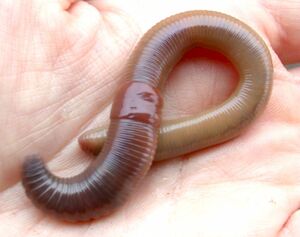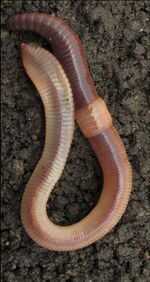Lumbricus terrestris: Difference between revisions
No edit summary |
No edit summary |
||
| Line 39: | Line 39: | ||
== Ecology == | == Ecology == | ||
''L. terrestris'' is an anecic earthworm, one which burrows far down into the soil | ''L. terrestris'' is an anecic earthworm, one which burrows far down into the soil and tends to eat the surface litter on the soil in which they live<ref name="mulci">A. Milcu, J. Schumacher, S. Scheu, "Earthworms (Lumbricus terrestris) affect plant seedling recruitment and microhabitat heterogeneity", ''Functional Ecology , Apr., 2006, Vol. 20, No. 2 (Apr., 2006), pp. 261-268''. April 2006. Retrieved 5/1/2022.</ref>. | ||
=== Diet === | === Diet === | ||
Revision as of 13:04, 2 May 2022

| |
| Kingdom: | Animalia |
|---|---|
| Phylum: | Annelida |
| Class: | Clitellata |
| Order: | Opisthopora |
| Family: | Lumbricidae |
| Genus: | Lumbricus |
| Species: | L. terrestris |
| Source: Integrated Taxonomic Information System[1] | |
Lumbricus terrestris is a species of earthworm which has been distributed across a majority of the globe due to farming practices and commercial industries[2] Due to its wide distribution, the worm has a variety of common names, including nightcrawler, Canadian nightcrawler, and dewworm[1]. As an earthworm, its habits are critical to observe because of its effect on the soil structure around it. L. terrestris is thought to have originated from Europe, because its introduction occurs with European settlement; there has been some suggestions that the nightcrawler came first with the landing of the Mayflower in North America[3]. The environmental effect of this earthworm as an exotic species in North American temperate forests especially has only just started to be more intensely studied in the last three decades[2].
Description

The nightcrawler is a larger earthworm than some: length averages between 110-200 mm, with a diameter of 7-10 mm. The worm is a dark brown, with a reddish hue which fades towards the end, which is slightly flattened. [4]
Ecology
L. terrestris is an anecic earthworm, one which burrows far down into the soil and tends to eat the surface litter on the soil in which they live[5].
Diet
Reproduction
Effect as an Invasive Species
References
- ↑ 1.0 1.1 "Integrated Taxonomic Information System - Report", ITIS USGS Open-File Report 2006-1195: Nomenclature", USGS, n.d.. Retrieved 5/1/2022.
- ↑ 2.0 2.1 Patrick J Bohlen, Stefan Scheu, Cindy M Hale, Mary Ann McLean, Sonja Migge, Peter M Groffman, and Dennis Parkinson, "Non-native invasive earthworms as agents of change in northern temperate forests", Front Ecol Environ 2004; 2(8): 427–435, 2004. Retrieved 5/1/2022.
- ↑ Nicholas Henshue, "Earthworm Diversity", Soil Ecology: University at Buffalo, 4/6/2022. Retrieved 5/1/2022.
- ↑ S James, "Data Sheet: Lumbricus Terrestris", CABI, Invasive Species Compendium, 22/12/10. Retrieved 5/1/2022.
- ↑ A. Milcu, J. Schumacher, S. Scheu, "Earthworms (Lumbricus terrestris) affect plant seedling recruitment and microhabitat heterogeneity", Functional Ecology , Apr., 2006, Vol. 20, No. 2 (Apr., 2006), pp. 261-268. April 2006. Retrieved 5/1/2022.